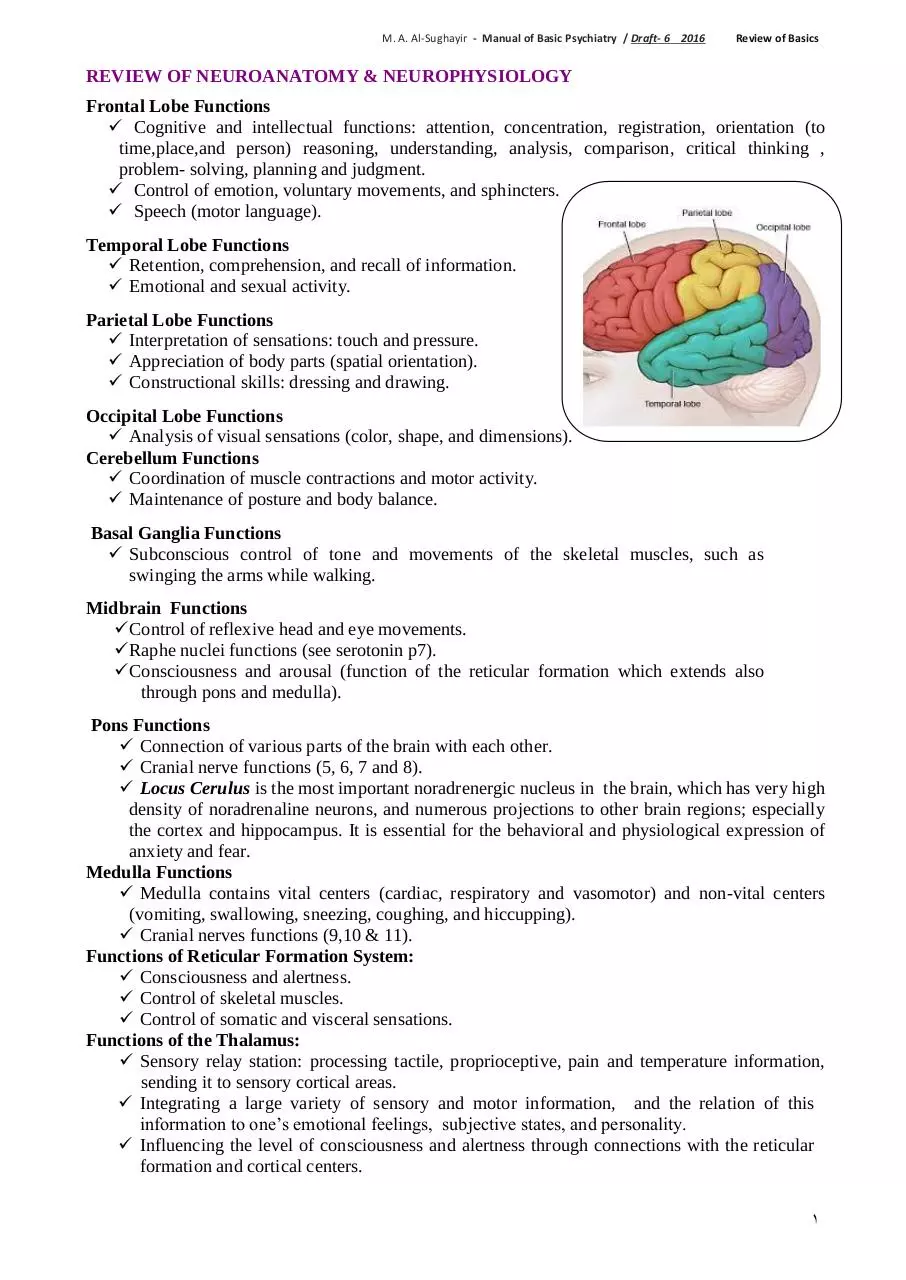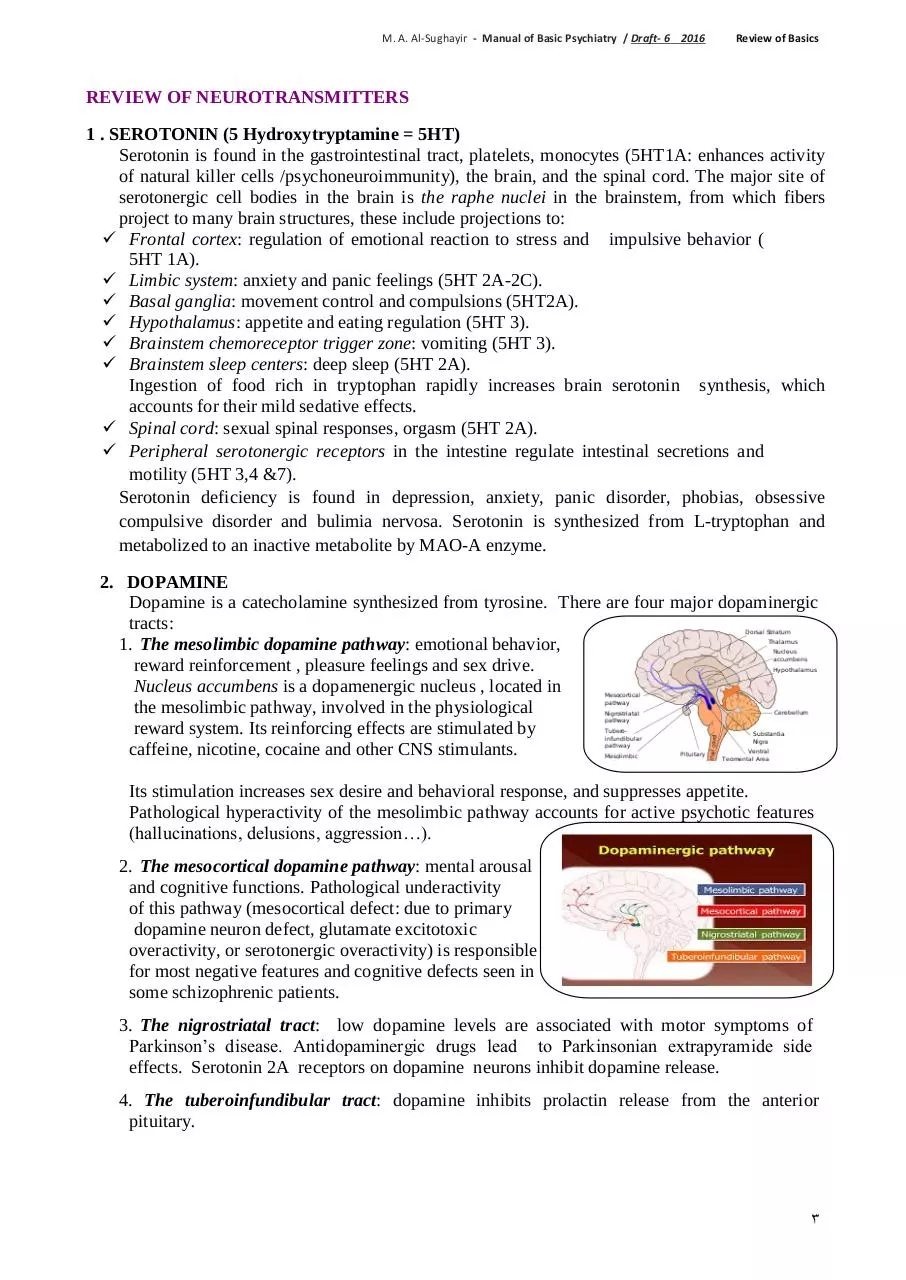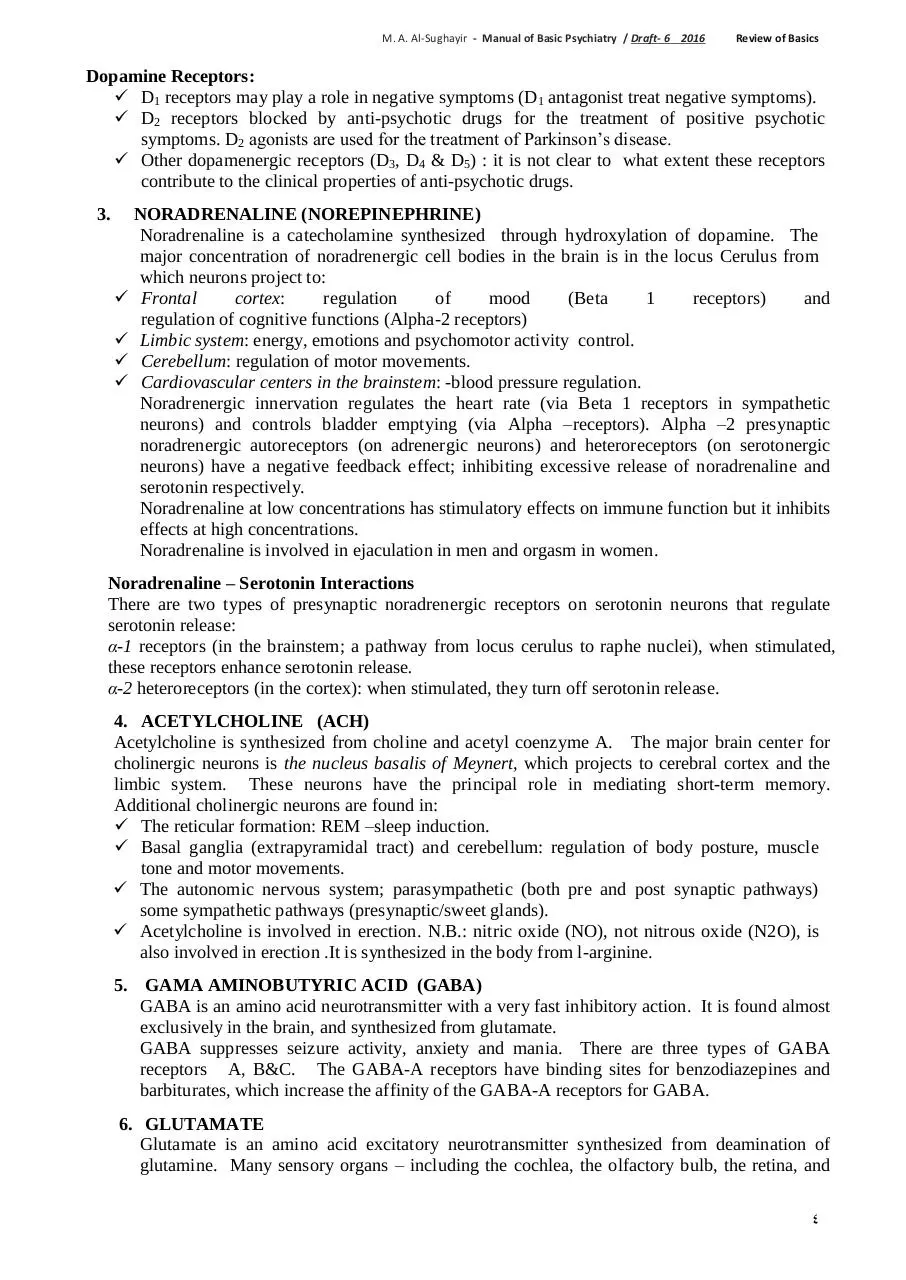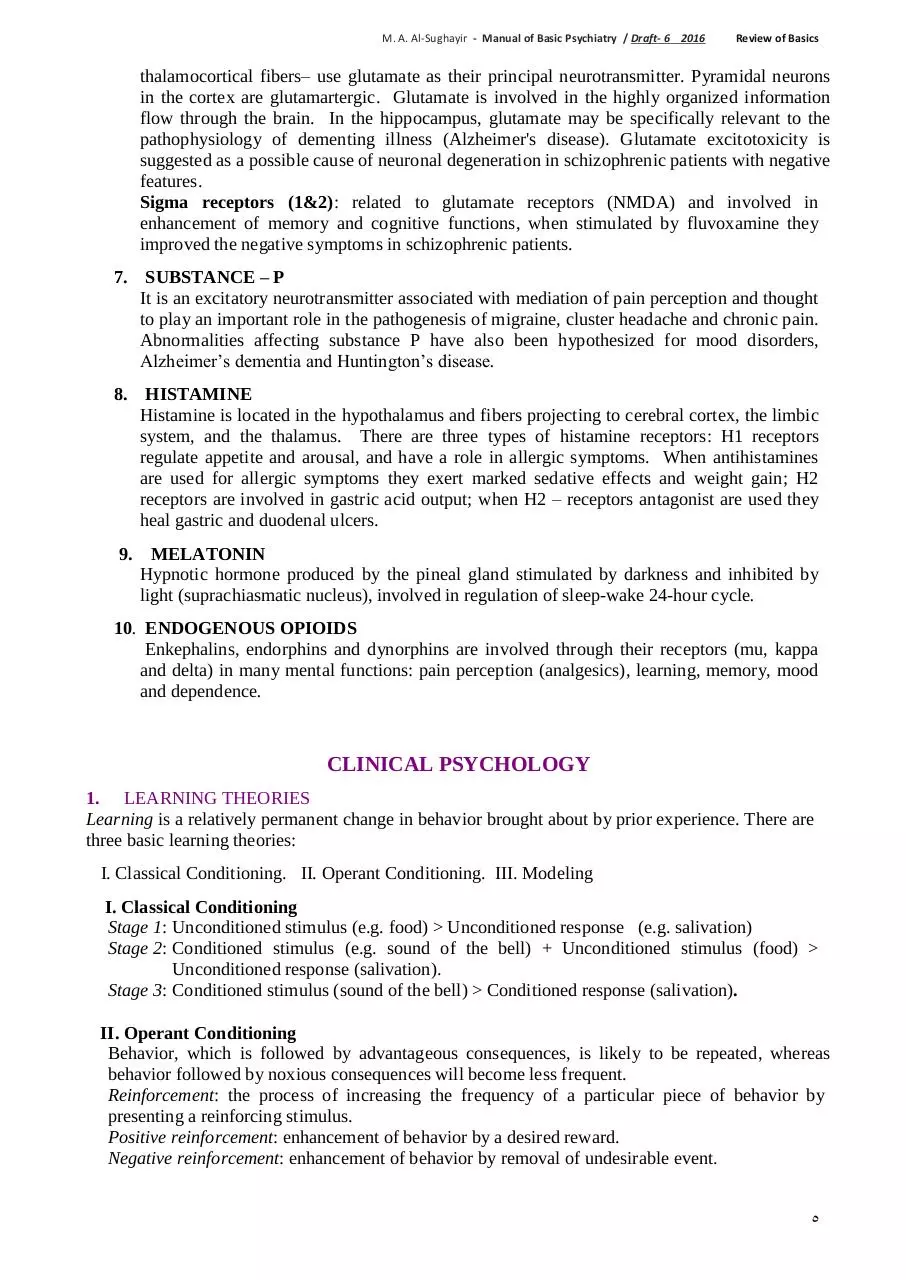Review of Basic Neuroscience (PDF)
File information
Author: user
This PDF 1.5 document has been generated by Microsoft® Word 2010, and has been sent on pdf-archive.com on 19/01/2018 at 14:39, from IP address 77.31.x.x.
The current document download page has been viewed 627 times.
File size: 795.2 KB (8 pages).
Privacy: public file





File preview
M. A. Al-Sughayir - Manual of Basic Psychiatry / Draft- 6 2016
Review of Basics
REVIEW OF NEUROANATOMY & NEUROPHYSIOLOGY
Frontal Lobe Functions
Cognitive and intellectual functions: attention, concentration, registration, orientation (to
time,place,and person) reasoning, understanding, analysis, comparison, critical thinking ,
problem- solving, planning and judgment.
Control of emotion, voluntary movements, and sphincters.
Speech (motor language).
Temporal Lobe Functions
Retention, comprehension, and recall of information.
Emotional and sexual activity.
Parietal Lobe Functions
Interpretation of sensations: touch and pressure.
Appreciation of body parts (spatial orientation).
Constructional skills: dressing and drawing.
Occipital Lobe Functions
Analysis of visual sensations (color, shape, and dimensions).
Cerebellum Functions
Coordination of muscle contractions and motor activity.
Maintenance of posture and body balance.
Basal Ganglia Functions
Subconscious control of tone and movements of the skeletal muscles, such as
swinging the arms while walking.
Midbrain Functions
Control of reflexive head and eye movements.
Raphe nuclei functions (see serotonin p7).
Consciousness and arousal (function of the reticular formation which extends also
through pons and medulla).
Pons Functions
Connection of various parts of the brain with each other.
Cranial nerve functions (5, 6, 7 and 8).
Locus Cerulus is the most important noradrenergic nucleus in the brain, which has very high
density of noradrenaline neurons, and numerous projections to other brain regions; especially
the cortex and hippocampus. It is essential for the behavioral and physiological expression of
anxiety and fear.
Medulla Functions
Medulla contains vital centers (cardiac, respiratory and vasomotor) and non-vital centers
(vomiting, swallowing, sneezing, coughing, and hiccupping).
Cranial nerves functions (9,10 & 11).
Functions of Reticular Formation System:
Consciousness and alertness.
Control of skeletal muscles.
Control of somatic and visceral sensations.
Functions of the Thalamus:
Sensory relay station: processing tactile, proprioceptive, pain and temperature information,
sending it to sensory cortical areas.
Integrating a large variety of sensory and motor information, and the relation of this
information to one’s emotional feelings, subjective states, and personality.
Influencing the level of consciousness and alertness through connections with the reticular
formation and cortical centers.
1
M. A. Al-Sughayir - Manual of Basic Psychiatry / Draft- 6 2016
Review of Basics
Functions of the Hypothalamus
Hypothalamus preserves body homeostasis through regulation of:
Food intake: Feeding/hunger center, located in the lateral side of hypothalamus, which is
chronically active and its activity is transiently inhibited by the activity in the satiety center,
located in the ventro-medial side, after the ingestion of food.
Water intake (superiolateral part of Hypothalamus).
Sleep (suprachiasmatic nucleus: light reduces melatonin in pineal gland whereas darkness
enhances melatonin secretion).
Temperature :
Antirising center in the anterior hypothalamus, mediates the parasympathetic system to
increase body heat loss, thus reducing body temperature.
Antidrop center in the posterior hypothalamus mediates the sympathetic system to reduce
body heat loss.
Higher control of hormones: Catecholamines-vasopressin-oxytocin-ACTH-TSH-FSH-LHProlactin and growth hormones .
Higher control of the autonomic nervous system
Parasympathetic (by anterior hypothalamus).
Sympathetic (by posterior hypothalamus).
The Autonomic Nervous System
It is distributed throughout the central and peripheral nervous system, divided into two parts:
the sympathetic and the parasympathetic.
The sympathetic nervous system
β1 stimulation : acceleration in the heart rate and increase in the myocardial contractility.
β2 stimulation: vasodilatation of skeletal muscles and coronary artries, bronchodilatation, and
relaxation of uterus, intestines and bladder.
α receptor stimulation : constriction of the arterioles of the skin and intestine, mydriasis,
piloerection, sweating, ejaculation, closure of the sphincters and reduction of salivary glands
secretion.
The parasympathetic nervous system
It aims at restoring energy. It slows the heart rate, constricts the pupils, increases peristalsis
of the intestine and glandular activities (increasing secretions), opens the sphincters and
contracts the bladder wall. The parasympathetic neurons also facilitate erection.
Limbic System
Components: Cingulate gyrus - hippocampus(temporal lobe) - amygdala- parahippocampal
gyrus- hypothalamus-anterior nucleus of thalamus - major tracts connecting the system.
Functions:
o Emotional and behavioral responses (anger,fear, etc.). Emotions may be modified by
thinking and judgment (frontal lobe functions). However, limbic circuits have prolonged
after-discharge following stimulation. Thus, emotional responses are generally prolonged
and outlast the stimuli that initiate them.
o Sexual feelings and pleasure: norepinephrine is involved
in ejaculation (males) and orgasm (females).
o Recent memory.
The Gate Control Theory of Pain
In the dorsal horn of the spinal cord, competing signals and neurotransmitters can open or
close the gate on painful perceptions. Substance P is involved in altering the pain
threshold. Serotonin in descending pathways has an inhibitory effect (closing the gate).
Endorphin deficiency seems to correlate with the augmentation of afferent stimuli.
2
M. A. Al-Sughayir - Manual of Basic Psychiatry / Draft- 6 2016
Review of Basics
REVIEW OF NEUROTRANSMITTERS
1 . SEROTONIN (5 Hydroxytryptamine = 5HT)
Serotonin is found in the gastrointestinal tract, platelets, monocytes (5HT1A: enhances activity
of natural killer cells /psychoneuroimmunity), the brain, and the spinal cord. The major site of
serotonergic cell bodies in the brain is the raphe nuclei in the brainstem, from which fibers
project to many brain structures, these include projections to:
Frontal cortex: regulation of emotional reaction to stress and impulsive behavior (
5HT 1A).
Limbic system: anxiety and panic feelings (5HT 2A-2C).
Basal ganglia: movement control and compulsions (5HT2A).
Hypothalamus: appetite and eating regulation (5HT 3).
Brainstem chemoreceptor trigger zone: vomiting (5HT 3).
Brainstem sleep centers: deep sleep (5HT 2A).
Ingestion of food rich in tryptophan rapidly increases brain serotonin synthesis, which
accounts for their mild sedative effects.
Spinal cord: sexual spinal responses, orgasm (5HT 2A).
Peripheral serotonergic receptors in the intestine regulate intestinal secretions and
motility (5HT 3,4 &7).
Serotonin deficiency is found in depression, anxiety, panic disorder, phobias, obsessive
compulsive disorder and bulimia nervosa. Serotonin is synthesized from L-tryptophan and
metabolized to an inactive metabolite by MAO-A enzyme.
2. DOPAMINE
Dopamine is a catecholamine synthesized from tyrosine. There are four major dopaminergic
tracts:
1. The mesolimbic dopamine pathway: emotional behavior,
reward reinforcement , pleasure feelings and sex drive.
Nucleus accumbens is a dopamenergic nucleus , located in
the mesolimbic pathway, involved in the physiological
reward system. Its reinforcing effects are stimulated by
caffeine, nicotine, cocaine and other CNS stimulants.
Its stimulation increases sex desire and behavioral response, and suppresses appetite.
Pathological hyperactivity of the mesolimbic pathway accounts for active psychotic features
(hallucinations, delusions, aggression…).
2. The mesocortical dopamine pathway: mental arousal
and cognitive functions. Pathological underactivity
of this pathway (mesocortical defect: due to primary
dopamine neuron defect, glutamate excitotoxic
overactivity, or serotonergic overactivity) is responsible
for most negative features and cognitive defects seen in
some schizophrenic patients.
3. The nigrostriatal tract: low dopamine levels are associated with motor symptoms of
Parkinson’s disease. Antidopaminergic drugs lead to Parkinsonian extrapyramide side
effects. Serotonin 2A receptors on dopamine neurons inhibit dopamine release.
4. The tuberoinfundibular tract: dopamine inhibits prolactin release from the anterior
pituitary.
3
M. A. Al-Sughayir - Manual of Basic Psychiatry / Draft- 6 2016
Review of Basics
Dopamine Receptors:
D1 receptors may play a role in negative symptoms (D1 antagonist treat negative symptoms).
D2 receptors blocked by anti-psychotic drugs for the treatment of positive psychotic
symptoms. D2 agonists are used for the treatment of Parkinson’s disease.
Other dopamenergic receptors (D3, D4 & D5) : it is not clear to what extent these receptors
contribute to the clinical properties of anti-psychotic drugs.
3.
NORADRENALINE (NOREPINEPHRINE)
Noradrenaline is a catecholamine synthesized through hydroxylation of dopamine. The
major concentration of noradrenergic cell bodies in the brain is in the locus Cerulus from
which neurons project to:
Frontal
cortex:
regulation
of
mood
(Beta
1
receptors)
and
regulation of cognitive functions (Alpha-2 receptors)
Limbic system: energy, emotions and psychomotor activity control.
Cerebellum: regulation of motor movements.
Cardiovascular centers in the brainstem: -blood pressure regulation.
Noradrenergic innervation regulates the heart rate (via Beta 1 receptors in sympathetic
neurons) and controls bladder emptying (via Alpha –receptors). Alpha –2 presynaptic
noradrenergic autoreceptors (on adrenergic neurons) and heteroreceptors (on serotonergic
neurons) have a negative feedback effect; inhibiting excessive release of noradrenaline and
serotonin respectively.
Noradrenaline at low concentrations has stimulatory effects on immune function but it inhibits
effects at high concentrations.
Noradrenaline is involved in ejaculation in men and orgasm in women.
Noradrenaline – Serotonin Interactions
There are two types of presynaptic noradrenergic receptors on serotonin neurons that regulate
serotonin release:
α-1 receptors (in the brainstem; a pathway from locus cerulus to raphe nuclei), when stimulated,
these receptors enhance serotonin release.
α-2 heteroreceptors (in the cortex): when stimulated, they turn off serotonin release.
4. ACETYLCHOLINE (ACH)
Acetylcholine is synthesized from choline and acetyl coenzyme A. The major brain center for
cholinergic neurons is the nucleus basalis of Meynert, which projects to cerebral cortex and the
limbic system. These neurons have the principal role in mediating short-term memory.
Additional cholinergic neurons are found in:
The reticular formation: REM –sleep induction.
Basal ganglia (extrapyramidal tract) and cerebellum: regulation of body posture, muscle
tone and motor movements.
The autonomic nervous system; parasympathetic (both pre and post synaptic pathways)
some sympathetic pathways (presynaptic/sweet glands).
Acetylcholine is involved in erection. N.B.: nitric oxide (NO), not nitrous oxide (N2O), is
also involved in erection .It is synthesized in the body from l-arginine.
5.
GAMA AMINOBUTYRIC ACID (GABA)
GABA is an amino acid neurotransmitter with a very fast inhibitory action. It is found almost
exclusively in the brain, and synthesized from glutamate.
GABA suppresses seizure activity, anxiety and mania. There are three types of GABA
receptors A, B&C. The GABA-A receptors have binding sites for benzodiazepines and
barbiturates, which increase the affinity of the GABA-A receptors for GABA.
6. GLUTAMATE
Glutamate is an amino acid excitatory neurotransmitter synthesized from deamination of
glutamine. Many sensory organs – including the cochlea, the olfactory bulb, the retina, and
4
M. A. Al-Sughayir - Manual of Basic Psychiatry / Draft- 6 2016
Review of Basics
thalamocortical fibers– use glutamate as their principal neurotransmitter. Pyramidal neurons
in the cortex are glutamartergic. Glutamate is involved in the highly organized information
flow through the brain. In the hippocampus, glutamate may be specifically relevant to the
pathophysiology of dementing illness (Alzheimer's disease). Glutamate excitotoxicity is
suggested as a possible cause of neuronal degeneration in schizophrenic patients with negative
features.
Sigma receptors (1&2): related to glutamate receptors (NMDA) and involved in
enhancement of memory and cognitive functions, when stimulated by fluvoxamine they
improved the negative symptoms in schizophrenic patients.
7.
SUBSTANCE – P
It is an excitatory neurotransmitter associated with mediation of pain perception and thought
to play an important role in the pathogenesis of migraine, cluster headache and chronic pain.
Abnormalities affecting substance P have also been hypothesized for mood disorders,
Alzheimer’s dementia and Huntington’s disease.
8.
HISTAMINE
Histamine is located in the hypothalamus and fibers projecting to cerebral cortex, the limbic
system, and the thalamus. There are three types of histamine receptors: H1 receptors
regulate appetite and arousal, and have a role in allergic symptoms. When antihistamines
are used for allergic symptoms they exert marked sedative effects and weight gain; H2
receptors are involved in gastric acid output; when H2 – receptors antagonist are used they
heal gastric and duodenal ulcers.
9.
MELATONIN
Hypnotic hormone produced by the pineal gland stimulated by darkness and inhibited by
light (suprachiasmatic nucleus), involved in regulation of sleep-wake 24-hour cycle.
10. ENDOGENOUS OPIOIDS
Enkephalins, endorphins and dynorphins are involved through their receptors (mu, kappa
and delta) in many mental functions: pain perception (analgesics), learning, memory, mood
and dependence.
CLINICAL PSYCHOLOGY
1. LEARNING THEORIES
Learning is a relatively permanent change in behavior brought about by prior experience. There are
three basic learning theories:
I. Classical Conditioning. II. Operant Conditioning. III. Modeling
I. Classical Conditioning
Stage 1: Unconditioned stimulus (e.g. food) > Unconditioned response (e.g. salivation)
Stage 2: Conditioned stimulus (e.g. sound of the bell) + Unconditioned stimulus (food) >
Unconditioned response (salivation).
Stage 3: Conditioned stimulus (sound of the bell) > Conditioned response (salivation).
II. Operant Conditioning
Behavior, which is followed by advantageous consequences, is likely to be repeated, whereas
behavior followed by noxious consequences will become less frequent.
Reinforcement: the process of increasing the frequency of a particular piece of behavior by
presenting a reinforcing stimulus.
Positive reinforcement: enhancement of behavior by a desired reward.
Negative reinforcement: enhancement of behavior by removal of undesirable event.
5
M. A. Al-Sughayir - Manual of Basic Psychiatry / Draft- 6 2016
Review of Basics
III. Modeling occurs when the behavior of an individual (the observer) is affected by the
opportunity to observe the behavior of another person (the model).
Clinical Uses of Learning Theories:
- Treatment of phobias (systemic desensitization and flooding).
- Treatment of obsessive rituals (exposure and response prevention).
- Relaxation training (for anxiety).
- Aversion therapy (for alcoholism and sexual deviation).
2. COGNITIVE THEORY
It emphasizes the impact of interpretation of events, expectations, and process of thinking
about oneself, people, the environment, the past, and the future on the mood and behavior.
Depression and anxiety result from, and complicated by, wrong automatic thoughts e.g. “I am
bad person”. Correction of erroneous thoughts with cognitive therapy usually relieves patients
from negative emotions (see cognitive therapy Chapter 24 for clinical applications in
psychiatry).
3. PSYCHOANALYTIC THEORY
A -Topographic model of the mind: It divides the mind into three regions:
1. The conscious 2. The unconscious 3. The preconscious
Each of which has its own characteristics:
1. The conscious: The part of the mind in which perceptions coming from the mind, the body and
from the outside world are brought into awareness. Its content can be communicated by
means of language or behavior.
2. The unconscious: The part of the mind that contains the instinctual wishes and drives (selfpreservative drives and sexual instincts) and represses them; keeping them out of conscious
awareness through resistance to remembering.
3. The preconscious: The part of the mind that comprises those mental processes, contents and
events that are capable of being brought into conscious awareness by deliberate focusing of
attention on the memory.
B - Structural Theory Model (Ego Psychology): It divides the psychological apparatus into the id,
the ego and the super ego.
1. The “id”: It includes the unconscious instinctual wishes and drives, and operates according to
the pleasure principle (it lacks the capacity to delay or modify the instinctual drives).
2. The “ego”: It attempts to achieve and coordinate optimal gratification of instinctual wishes and
drives while maintaining good relations with the demands of the outer world and external
reality.
3. The “superego”: It includes internalized moral values, prohibitions and standards; and offers
approval or disapproval. The superego conducts an ongoing scrutiny of the person’s feelings,
thoughts, and behavior. It establishes and maintains the person's moral conscience.
Defense Mechanism: subconscious mental processes used by a person to deal with distressing
situations or internal conflicts.
1. Acting out: impulsive behavior in expression of a suppressed desire or conflict to avoid being
conscious of the emotions that accompany it. It occurs mainly in children (e.g., tantrums),
adolscents (e.g., motiveless assaults), and patiets with boredrline personality disorder (e.g.,
destructive behavior, deliberate self-harm).
2. Compensation: covering up for a weakness in the personality by over- emphasizing another
desirable trait. E.g., a person with social anxiety becomes known for his expressive writings.
3. Conversion: symbolic expression of intrapsychic conflict through physical symptoms. E.g., a
student in the exam suddenly develops pseudosiezure. By so doing, two kinds of gains he
achieves:
6
M. A. Al-Sughayir - Manual of Basic Psychiatry / Draft- 6 2016
Review of Basics
1. Primary gain: relief of intrapsychic distress.
2. Secondary gain: to be excused from the exam.
It occurs mainly in conversion disorder.
4. Denial: rejection or disapproval of distressing reality (e.g., faults, poor performance, physical
illness, loss of a loved person).
5. Displacement: transfer and discharge of bent-up intense emotions (e.g. anger, fear) on objects
less dangerous than those arousing them. E.g., a man harassed by his boss at work, comes home
and yells at his wife.
6. Identification: matching and modeling another person's behavior or attitude. E.g., a patient
develops psychosomatic chest pain after death of a relative of heart attack.
7. Intellectualization: overemphasizing logical analysis of a situation through philosophical
discussions to avoid distressing emotions accompanying it. E.g., a patient told to have cancer
appeared self-composed and talked a lot about how cancer is challenging to doctors.
8. Projection: exempting self from one’s own faults, bad motives, or wrong doings by attributing
them to someone else. E.g., someone who dislikes a colleague may attribute to him feelings of
anger, and in turn dislike. In this way, his own feelings of dislike may appear justified and
become less distressing.
9. Rationalization: justifying a behavior or attitude with logical, plausible reasons, but these are
not the real reasons. E.g., a student states, “I was able to get grade “A+”, but I was afraid of evil
eye, that is why I left some questions unanswered.”
10. Reaction formation: contolling a distressing feelings by adopting the opposite behavior or
attitude to that which would reflect the true feelings. E.g. a medical student who has been
dismissed from medical college because of poor achievement and wished he continued
studying medicine tells his family he hates medicine.
11. Regression: a return to an earlier and more comfortable patterns of thinking and behavior
involving less mature reaction and responsibility. E.g., an adolescent boy whose self-esteem
has been shattered reverts to child-like "show-off" behavior.
12. Splitting: dividing his evaluation of others and situations into two extremes either all good or
all bad rather than considering the full range of their qualities. E.g. a patient with borderline
personality disorder overidealizes some doctors and devalues others.
13. Sublimation: diverting unacceptable drives (particularly sexual and aggressive) into socially
acceptable channels such as creative activities. E.g. turning chronic anger feelings into
vigorous sporting activities.
14. Uudoing: doing something to counteract unacceptable desires. E.g. a teenager who feels guilty
about masturbation ritually cleans his hands excessively following each occurrence of the act.
4. INTELLIGENCE TESTING
Intelligence is the ability to solve environmental problems and to adapt to changes.
Two common tests are:
A. Stanford - Binet test (age 2 to 18 years).
B. Wechsler scales (for children and adults).
Intelligence tests assess intellectual ability; verbal/vocabulary, visual-spatial (picture assembly),
math skills, and performance skills.
Intelligence Quotient (IQ) = (mental age/chronological age) x 100
7
M. A. Al-Sughayir - Manual of Basic Psychiatry / Draft- 6 2016
Review of Basics
IQ scores: average normal (100 +10), bright normal (120), superior (> 130), dull normal (80-90),
borderline (70-79), mild mental retardation (50-70), moderate mental retardation (35-49), severe
mental retardation (20-34), and profound mental retardation (< 20).
5. PERSONALITY TESTING:
Personality is the distinctive patterns of thought, emotion, and behavior that define an individual’s
personal style and influence his or her interactions with the environment.
Personality measures
A- There are many personality tests that measure the various traits of normal personality, the most
widely used are the following:
o
o
o
o
The five factor model of personality (FFM).
The Myers-Briggs Type Indicator (MBTI).
The 16 Personality Factor Questionnaire (16 PF).
The California Psychological Inventory (CPI).
They are helpful in predicting behavior, achievement, and adaptation to stress.They can be used in
many settings like academic, career, and occupational selection.
B- In clinical psychology practice, there are tests used to detect abnormal patterns of personality.
Objective Tests (questions with standardized-response format that can be objectively scored).
o Eysenck Personality Inventory (EPI).
o Minnesota Multiphasic Personality Inventory (MMPI-2).
Projective Tests (interpretation of ambiguous stimuli with no objective structured- answer
format).
o Rorschach test: to identify disordered thoughts and defense mechanisms through
interpretation of ink blots.
o Thematic Apperception Test (TAT): to evaluate motivations and attitude behind behaviors
through creating stories based on pictures of people in various situations.
Several intelligence and personality tests are available in Arabic language, and validated in some
Arab communities.
Clinical psychologists play important roles within the psychiatric team for both patients'
assessment (e.g., IQ, personality) and treatment (e.g., cognitive-behavior therapy).
8
Download Review of Basic Neuroscience
Review of Basic Neuroscience.pdf (PDF, 795.2 KB)
Download PDF
Share this file on social networks
Link to this page
Permanent link
Use the permanent link to the download page to share your document on Facebook, Twitter, LinkedIn, or directly with a contact by e-Mail, Messenger, Whatsapp, Line..
Short link
Use the short link to share your document on Twitter or by text message (SMS)
HTML Code
Copy the following HTML code to share your document on a Website or Blog
QR Code to this page

This file has been shared publicly by a user of PDF Archive.
Document ID: 0000723273.